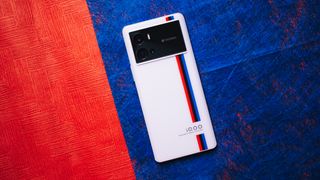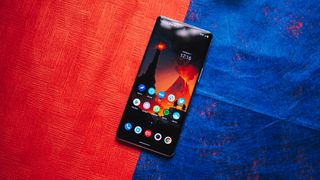iQOO 9 Pro long-term review: A stellar alternative to the OnePlus 10 Pro
With a striking design and excellent cameras, the iQOO 9 Pro continues to be a standout device.

iQOO isn't a brand that will be familiar to those in the west, but the Vivo sub-brand has made inroads in Asian markets over the last two years. iQOO bills itself as a gaming-focused entity, and its products are catered toward a younger audience. Last year's iQOO 7 Legend was one of the best value flagships in the market, and the brand forayed into the budget category with the Z series.
iQOO turned things up a gear in 2022 with the launch of the iQOO 9 Pro. Like the iQOO 7, the phone is made in collaboration with BMW's M division and features the motorsport brand's livery on the back. It isn't lacking on the internals either, featuring a Snapdragon 8 Gen 1 chipset, a QHD+ AMOLED screen, camera with gimbal stabilization, and 120W fast charging. It's clear that the iQOO 9 Pro uses a lot of the same parts as its BBK siblings, including the Find X5 Pro, Vivo X80 Pro, and the OnePlus 10 Pro, and the gaming-focused strategy gives the outfit a new target audience.
I used the iQOO 9 Pro back when it launched but wasn't able to do a review, so I'm do a shorter take now that the phone has picked up the Android 13 update. The phone is limited to a few Southeast Asian countries, and in India it is available for ₹59,990 ($853) for the version with 8GB of RAM and 256GB of storage.
There's a 12GB/256GB model that's available for ₹54,990 ($920), and a standard variant dubbed the iQOO 9 with an FHD+ screen, slightly different hardware in the form of the Snapdragon 888+, and a smaller 4350mAh battery with 120W tech for ₹42,990 ($564). The standard model has gimbal stabilization tech, but switches out the 50MP lens for a 48MP sensor, and you get a 13MP wide-angle lens.

I generally like what Vivo is doing on the design front with its devices — the V23 and now the V25 series have attractive designs that stand out — and given that the iQOO 9 Pro is aimed at a younger audience, the device has a bold styling that calls attention to itself. I'm using the Legend edition, and it has a vertical line running through the back that pays homage to BMW's M series colors. The blue accent for the power button is also a nice addition, and the large camera housing at the back adds to the design flair.
The camera housing isn't quite as large as some of the POCO phones I used in recent years, but it comes close. The rectangular housing includes three sensors and the associated hardware for gimbal stabilization, and what I like about it is that it doesn't really protrude too much. The phone has a large 6.78-inch screen, and it is taller than even the Galaxy S22 Ultra by 1.5mm (coming in at 164.8mm). But what makes it slightly easier to use is the narrower width at 75.2mm. And at 204g, it is lighter than the Pixel 7 Pro, Galaxy S22 Ultra, and the Xiaomi 12 Pro.




The white color scheme combined with the splash of color running at the back gives the iQOO 9 Pro a lot of character, and it is one of the best-looking phones I used this year. The glass back also has a matte finish that feels wonderful to hold and use, and it doesn't pick up smudges. I like the design at the front as well, with iQOO doing a fantastic job curving the extremities of the device while ensuring that the panel itself is flat.
Another area where the iQOO 9 Pro comes out ahead is the in-screen reader; it is the largest of any phone I've used, and it is the fastest as well. It works unerringly thanks to the extra-large surface area, and I don't really understand why other brands don't use a similarly-large module on their devices.

On that note, the screen itself is just as vibrant as that on Realme and Vivo flagships, with the 6.78-inch AMOLED screen featuring 120Hz refresh with Dolby Vision and max brightness of 1500 nits for HDR content. It is marginally larger than the rest of the BBK portfolio, and it has stereo sound as well (albeit not as good as Xiaomi devices) and is generally a fantastic device for streaming media and playing games.
Continuing with the positives, the iQOO 9 Pro holds its own against the best Android phones on the hardware front, and although the Snapdragon 8 Gen 1 doesn't have the same efficiency figures as the 8+ Gen 1, it continues to deliver on the performance side of things. There have been no slowdowns whatsoever here, and I don't see that changing in 2023 and beyond.

Battery life is great as well, and although it has a smaller battery than the Find X5 Pro, it manages to last all day with ease. Of course, newer devices like the Zenfone 9 last longer thanks to the energy-efficient 8+ Gen 1, but the 9 Pro consistently delivers all-day use even with heavy workloads involving a lot of gaming. And you don't find any omissions on the charging front, with the device offering 120W wired charging along with 50W wireless and 10W reverse wireless charging.
iQOO touts a 20-minute mark for fully charging the battery, but in my use, that figure is closer to 30 minutes. That said, it is faster than just about any other phone I used this year, barring the Realme GT Neo 3 and its 150W charging tech.

Switching over to the cameras, the iQOO 9 Pro features a 50MP f/1.8 module with OIS and gimbal stabilization tech based on Vivo's latest phones, and it's joined by a 50MP wide-angle lens with a 150-degree field of view and 16MP zoom module with 2.5x optical zoom. If that wide-angle lens looks familiar, it's because it is the same sensor that's used in the OnePlus 10 Pro.







Given the caliber of the cameras, it's no wonder that the phone takes fabulous photos in just about any lighting situation. Daylight shots have plenty of detail and good dynamic range, but it's in low-light where the iQOO 9 Pro comes into its own, producing images with good color fidelity and little to no visible noise. iQOO isn't reinventing the wheel here, instead relying on the same camera tuning algorithms that Vivo uses on its devices, and that means you get standout shots in any scenario.
The wide-angle lens is decent enough in its own right, and the 150-degree field of view leads to interesting shots. It manages to deliver photos with the same color balance as the main lens, and does a brilliant job even in low-light situations. The Night Mode automatically kicks in at night and delivers better detail out of shadows and maintains highlights, and the resulting shots look great. Overall, the iQOO 9 Pro is on par with its BBK siblings in this area.

Finally, the software. The iQOO 9 Pro launched with Funtouch 12 based on Android 12, and it has picked up the Android 13 stable build at the start of November, 2022. One of the main reasons for writing this long-term take is to talk about the good things Vivo and other BBK brands are doing on the software front this year.
Vivo used to be one of the last brands to roll out platform updates to its phones, so it is great to see the brand introduce Android 13 to its devices just a few weeks after Samsung. For context, my Xiaomi 12 Pro is still on Android 12, and it doesn't look like the phone will get the Android 13 build before the end of the year.
As for the interface, Funtouch 13 has a lot of similarities to ColorOS 13, and it's clear that BBK is building out a unified software vision even though its various brands have their own naming. OxygenOS, Realme OS, and Funtouch OS share the same foundation as ColorOS, with each interface differing in minute ways and offering its own custom feature-set.

With the Android 13 build, ColorOS switched to a notification shade that has larger tiles for Wi-Fi and Bluetooth, but iQOO has retained the older ColorOS 12-style pane with six toggles. The settings page is also identical to older builds of ColorOS, and for the large part, using the interface is very similar to that of other devices in the BBK portfolio. The one thing I didn't like here is the bloatware; there is a lot of it, and it is in line with what Realme has on its devices these days.
While most of the bloatware can be uninstalled, there's a native browser that cannot be disabled, and it continues to send annoying ads via notifications. The best you can do here is disable notifications for the browser, and in subsequent versions I want iQOO to add the ability to uninstall it. Other than that, it's smooth sailing on the software side of things. There's a good amount of customizability, the interface feels modern, and it is optimized to take full advantage of the hardware and that sublime 120Hz panel.

Overall, the iQOO 9 Pro is an underrated gem that has a lot to offer. I really like the design of the Legend variant, and the hardware is on par with the best devices in this category. The cameras do a fantastic job as well, and you get a large AMOLED panel with 120Hz refresh, long-lasting battery with 120W charging tech, and software that has a lot of customizability.
With iQOO set to launch its 2023 portfolio in the coming weeks, the iQOO 9 Pro should get enticing discounts that will make it an even more attractive option if you're looking for a flagship that doesn't miss out in any area.
Be an expert in 5 minutes
Get the latest news from Android Central, your trusted companion in the world of Android

Harish Jonnalagadda is a Senior Editor overseeing Asia at Android Central. He leads the site's coverage of Chinese phone brands, contributing to reviews, features, and buying guides. He also writes about storage servers, audio products, and the semiconductor industry. Contact him on Twitter at @chunkynerd.